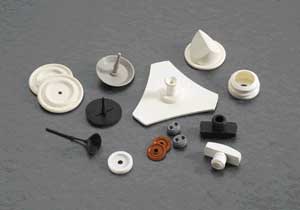Liquid Silicone Rubber Injection Molding
Liquid silicone rubber injection molding is the most recent addition to Jefferson Rubber Works, Inc.’s molding operations. The faster cycle times and improved performance properties of liquid silicone rubber make it a good choice for a variety of molded components. Liquid silicone rubber (LSR) remains flexible and elastic beyond -70°F and retains its properties up to 450°F which makes liquid silicone rubber a good candidate for gaskets, seals, boots, bellows, medical devices, and other applications where outdoor conditions are demanding. Cured liquid silicone rubber does not out-gas volatiles and plasticizers as other rubber compounds do – which has made it friendly to various assemblies that were formerly required to be ‘silicone free.’
Liquid Silicone Rubber Injection Molding Advantages
A key advantage of liquid silicone rubber over gum-based molding silicone compounds is the cycle time. Depending on the catalyst and cross-section of the molded component, the cycle times for liquid silicone molded parts range from 30 seconds to three minutes – with our average cure time of 25 to 50 seconds. In contrast, gum base silicones may take from 3 to 5 minutes total cycle time in a traditional silicone mold. Therefore, a single or two cavity injection mold will out-produce a multi-cavity mold. With fewer cavities needed to support production, tooling costs and lead times are reduced as well as part costs.
What is Liquid Silicone Rubber – LSR?
Silicone rubber is made up primarily of sand or silicon dioxide. This sand is then processed into a pure silicon metal which is reacted with methyl chloride. Other processes are then added to create various types of silicone including fluids and polymers to rubber bases and compounds. Silicones, unlike other plastics, have a composition of alternating atoms of silicon and carbon with organic side chains that impart curability and other properties. One type of silicone, LSR, possesses characteristics similar to thermoplastics but with some differences that are inherent in a thermoset.
Liquid Silicone Compound Suppliers
Liquid silicone molding compounds are purchased in Part A and Part B components from the major silicone producers. These compounds are usually mixed in a one-to-one ratio, with pigment added during the mixing process prior to the cure. Elevated temperature and molding pressures of the liquid silicone injection molding process enhance the cure. Liquid silicone rubber is supplied to us in airtight containers, pumped from the mix metering units into the tooling without exposure to the environment – therefore humidity is not a concern and generally this liquid silicone injection molding process is more consistent than traditional molding.
Tooling considerations for Liquid Silicone Injection Molding
Liquid silicone molding involves room temperature compounds mixed and pumped into a hot mold. Tooling designs are simplified as liquid silicone rubber flows readily into very thin cross sections, tight radii, and thick / thin features. Tooling surfaces do not have to be highly polished, and draft angles are not required to facilitate removal of the finished component from the tooling. When the cure cycle is complete, the molded silicone gasket can be removed without concern of distortion or tearing as the silicone is fully cured.
Silicon Rubber or Silicone Rubber? Silicone Rubber Molding or Silicone Molding?
We see silicon rubber or liquid silicon rubber called out frequently. Although silicon is often called out on prints, silicone is the widely accepted terminology used among in the synthetic rubber industry. Similarly, we see the terms liquid silicone rubber molding, liquid silicone rubber injection molding, liquid silicone molding, silicone liquid molding, liquid silicone injection molding, silicone injection molding, and silicone molding all used frequently and mostly interchangeably.
What is LSR Molding?
Liquid silicone rubber, or LSR, injection molding is a thermoset process that mixes two compounds together. This two-component compound is heat cured in a mold along with a catalyst which results in a completed molded part. Liquid Silicone Rubber – LSR – components are produced via an injection molding process comparable to plastic injection molding. However, there is a major difference between the two processes in that the material delivery system is cooled and the mold is heated. Liquid silicone rubber injection molding is different from the plastic injection molding process because it centers on mechanical mixing as opposed to pressurized impingement mixing.
Liquid silicone rubbers are cross linked via a platinum-catalyzed reaction. After curing, LSR’s cannot be reshaped or repurposed because it would take a high level of energy to break apart the cross-linked material. The structural make-up of LSR makes it useful for a wide range of temperatures and the bonds between the silicon and oxygen atoms means the polymer will not degrade easily. One liquid silicone rubber’s major advantage is the chemical inertness or purity. Combined with its ability to withstand sterilization processes, this makes LSR’s ideal for many medical uses. Most of liquid injection moldings, or LIM molding, is the result of the versatile properties of liquid silicone. Liquid silicone rubber possesses a high degree of heat resistance, high tensile strength, and flexibility. LSR also is very formable and may be colored or transparent as a finished product. Liquid silicone may also serve as excellent insulators or conductors depending on the exact compound composition.






